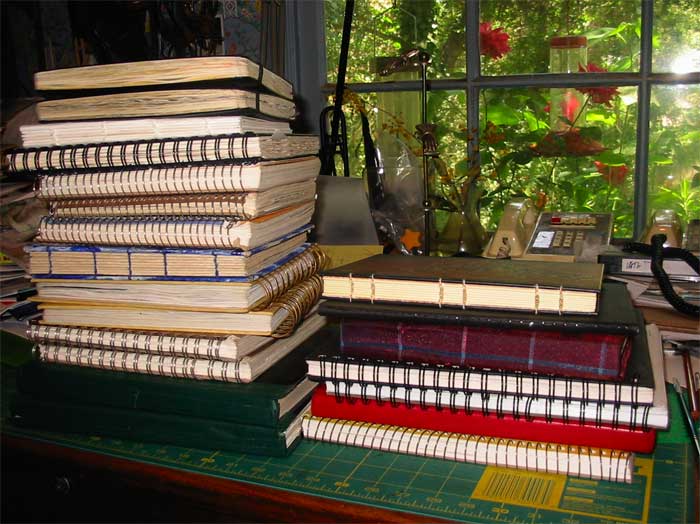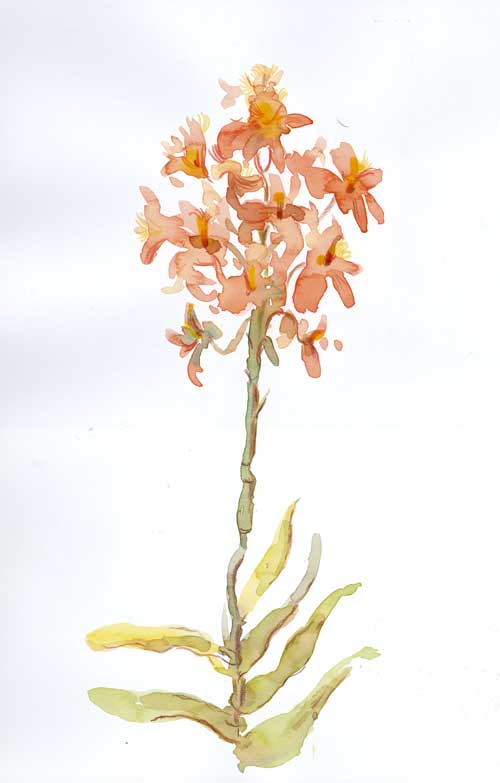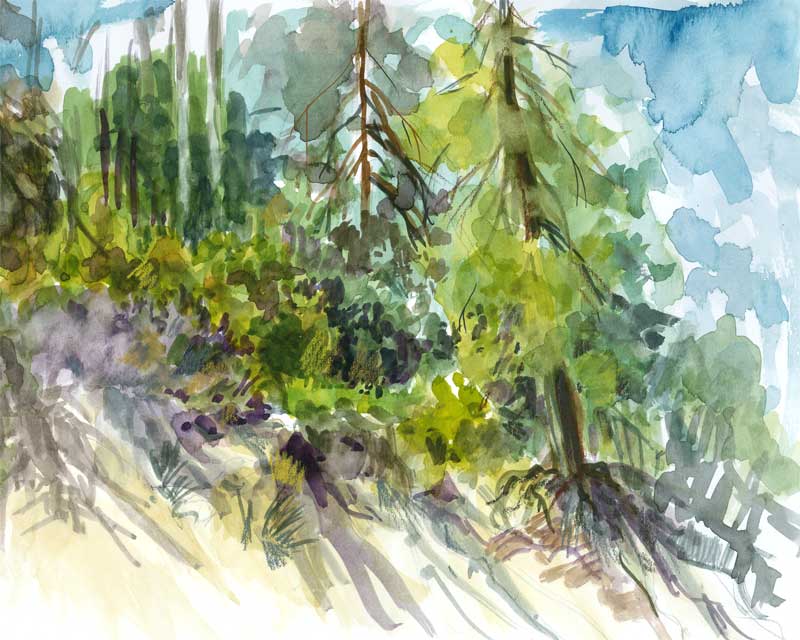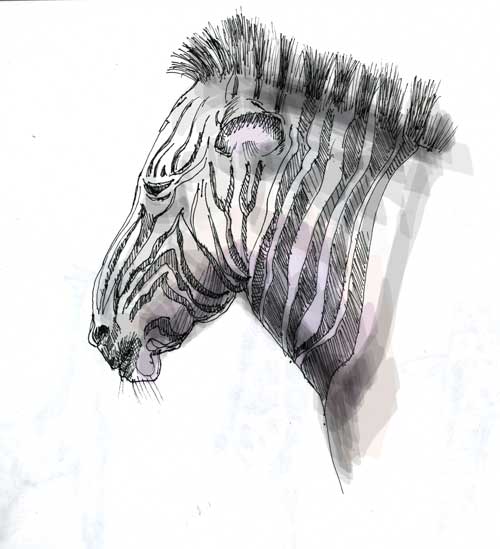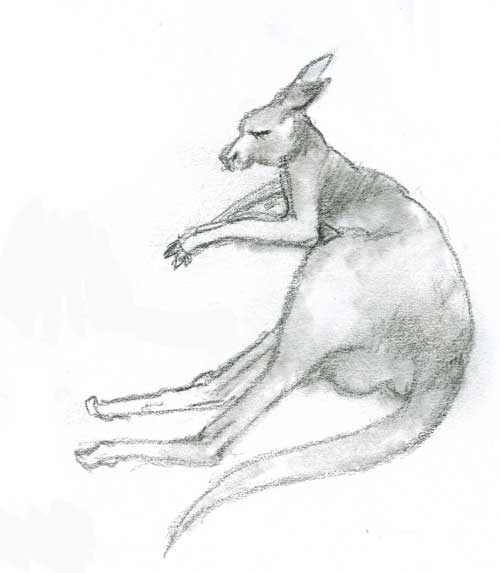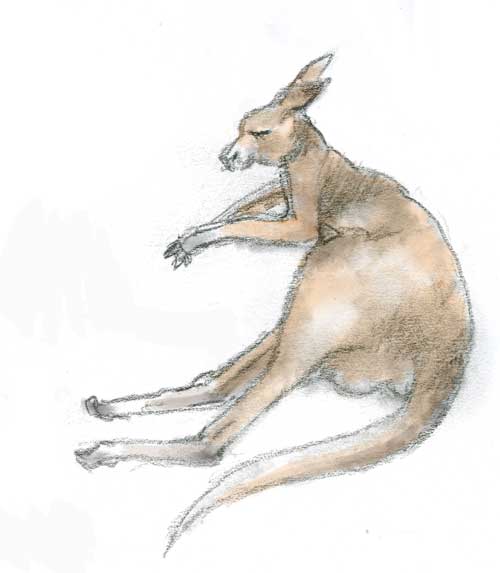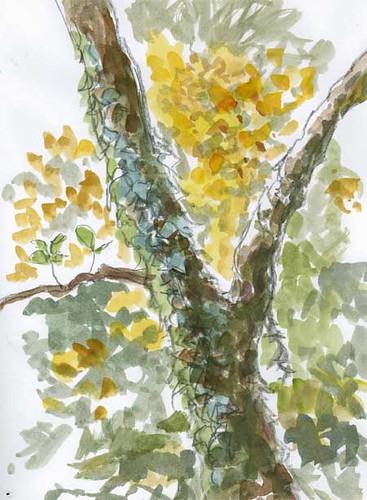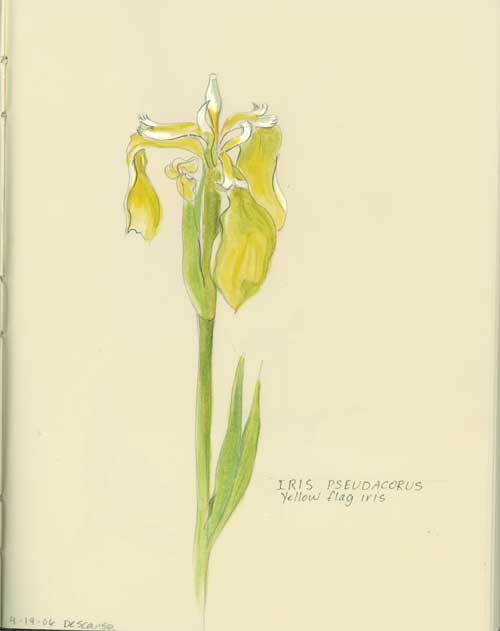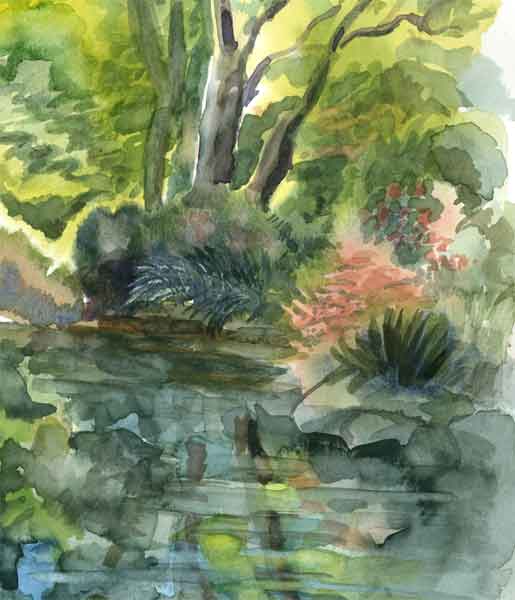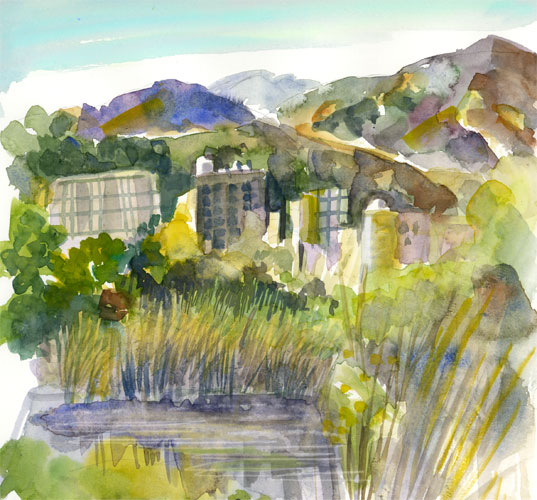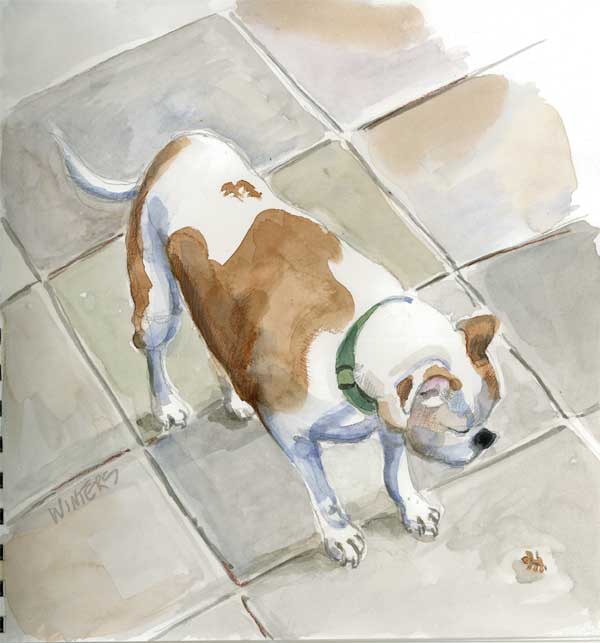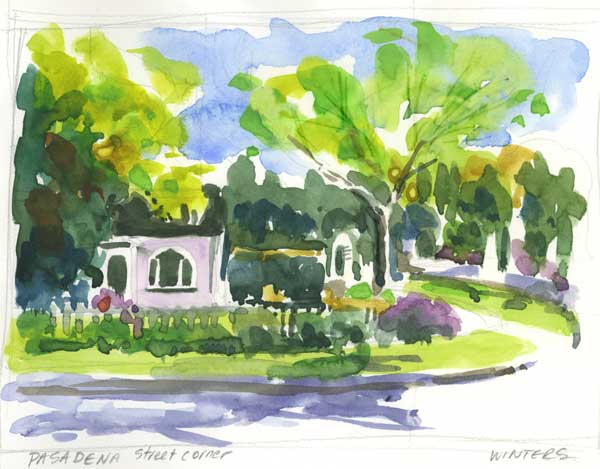Seriously addicted
Yes, I am seriously addicted to sketching. These are the sketchbooks I’ve used since March 03, when I returned to art after a 20 year hiatus and essentially started over from sketch, I mean, scratch.
The stack on the left is completed books. The stack on the right is books that are partially full – a little bit or a lot. Every one of these is precious to me for one reason or another. Like any place where practice is done, they are full of false starts, errors, bad perspective, wobbly lines, strange anatomy, half-baked ideas and more. But that’s what my creative journey is all about. The way I figure, the more mistakes I make the better chance I have of doing something right. So I try to make a lot of mistakes every day. The more the better, really.
I’ll be posting new Mandu drawings later today if you want to check back. She’s drinking her half and half with enthusiasm again, and that’s a good sign. Yesterday I did a whole series of “cat part” drawings – ears, eyes, tail, etc. But I need time to scan them and it’s midnight now.
Thank you everyone for your supportive comments during this emotionally stressful time. Some people might say “get over it, it’s just a cat,” but animal lovers know it’s not that simple at all and that relationships come in all shapes, sizes and species. Feeling your kindness helps ease the impending loss, whether it comes in days, weeks or longer. My husband reads your comments, too, and I know that it means a lot to him as well.
Epidendrum
I painted this epidendrum orchid in my back yard recently. The frilled, fringed flowers are commonly orange, yellow, red or cream colored and are borne on long spikes like this (I’ve only shown a part of it – the spike is probably 2 feet tall.) This painting was done in my 9 x 12 sketchbook as a study. I will likely do one on ‘real’ watercolor paper next. I added a little colored pencil for the accent parts.
This morning I’m off to paint at Descanso with my friend Robin and I’ve been looking forward to it all week.
Mandu is now living in the kitchen, on the floor, where she has a towel and all of her “things” close by. I see her moving from one to another, delicately touching them with her muzzle, to orient herself. We’re thinking that she may have some sense of light and darkness, but it is too soon to tell. At any rate, she does not appear distressed and is eating, drinking and washing her face as usual, although she’s not eating as much as usual and needs to be ‘reminded’ to eat, since she no longer gets the visual stimulus.
Blues in the Woods
Today we drove up into the Angeles Crest National Forest to hear some music at Newcomb’s Ranch Inn … the only restaurant/road house in the vast national forest. Specifically, we drove the 45 minutes or so from our home to hear bluesman Barry “Big B” Brenner. We met Barry several years ago when he played at a restaurant in our town, and since that time we’ve enjoyed his music at sites all over Los Angeles – from a barbecue joint in Monrovia to a cajun restaurant in Toluca Lake to an outdoor concert at a golf course. His rare appearances at Newcomb’s Ranch Inn are worth the drive. Barry has said on numerous occasions that his mission is to introduce people to traditional blues and the blues legends that are the foundation of so much treasured American music. With his 6 string, 12 string and National Resonator guitars, he serves up a rich mixture of delta slides, Piedmont rags and Texas stomps – including numerous original songs. My favorite songs in Barry’s repertoire include “Deep River Blues,” “San Francisco Bay Blues,” and “Step it up and Go,” – but everything he sings is excellent. If you like blues, visit his site at the link above and give a listen … And if you’re in LA, get on his mailing list to find out where he’s appearing.
Barry was taking a set break when we arrived, but when he returned to play, I pulled out my sketchbook and did a painting of some of the pines and chapparal that grow on a hill behind the inn. This time, I didn’t make any attempt at composition, I just painted it like it was … a brilliant cerulean sky with fair weather cumulus, constantly changing light, pine trees clinging to a bare granite cliff, thickets of manzanita and mesquite and clouds of blooming ceanothus. More paintings of spring in our local wilderness will be posted this week.
Blues, sunshine, fresh air, a new watermedia sketchbook recommended by Roz Stendahl, my waterbrush and paints … and my dear husband to take me there and enjoy it with me. I can’t imagine a better start to a 3-day weekend.
Edited to add: I thought you might be interested in seeing what the scene actually looked like. This was a snapshot I took of that hillside. You can barely see the corner of the roof of the building in the foreground. The trees were about 30 yards or so away.
What I found interesting was my perception (above) that I just painted it like it was. I see now that I must have been improvising quite a bit, but I wasn’t really aware that I was.

Zoo Story – Part 1
On our LA Zoo sketchcrawl on Saturday, I took along a bagful of different art supplies because I wanted to experiment drawing the animals using different tools that seemed appropriate for their textures and coloration. I’m going to be scanning them and posting them throughout the week, so please check back if you’re interested in seeing more. The smooth graphic lines of the zebra seemed to lend themself to ink, and our model posed quietly in the shade for quite a long time. Thank you, zebra – you were the most cooperative subject of the day! I scanned and painted it later in Photoshop – my drawing paper doesn’t lend itself to wash.
Next subject: A mother kangaroo who had recently given birth to a little girl “joey.” Following some of the advice given in David Rankin’s Fast Sketching Techniques I used a dark, soft pencil and brought a stomp to smudge the lines. I think this captures some of the feeling of the soft fur of the mother roo who was taking a much needed rest. That big lump under her tail is where her daughter is napping! After scanning the sketch I added a little Photoshop color from a reference photo so you can see the before and after. Rankin is certainly right, drawing with a smudgeable pencil does allow you to get a faster impression with volume – good for drawing animals that won’t hold still.
If you’re in the So. California area (from Santa Barbara to San Diego to San Bernardino) and you’d like the experience of drawing with a group of friendly art-loving people, drop me a note and I’ll put you on our list so you can find out about upcoming get-togethers.
My window view – a not so faraway place
This is my return to the “Draw the view from your window” challenge. My intention is to do it for every season and to notice the differences in foliage and flowers. The tree is a Chinese elm, a hardy and vigorous grower that puts up suckers all over the yard, and promiscuously drops seeds with wild abandon. This elm, in fact, is a child of the four large elms that line the front of our property. Unlike American elms they are not vulnerable to Dutch elm disease. Come to think of it, they’re not vulnerable to anything – even severe trimming and drought. You couldn’t kill them if you tried, which makes them a good plant for drought prone areas like ours.
I painted this in my sketchbook this afternoon, looking out my window onto the end of a sunny day – a welcome change from all the rain and cloudy weather. The colors snapped, the light was good and I just had to stop what I was doing. But here’s my question: If you paint a nature scene from life but you’re not outside, can you call it plein-air? Should I call it faux-air? Or office-air? I am so confused; I will have to ruminate on this for awhile.
Edited to add:
Here’s a fall window view …of the oak just to the left of the Chinese elm (elm not seen here.)
Yellow flag
A recent entry in my ‘purely botanical’ sketchbook. This yellow flag iris is quite commonly planted around bogs or ponds. This one grows at Descanso gardens near a pond with a weeping willow. This iris, native to Asia and Europe, became known as the French fleur-de-lis, and the word “flag” may refer to a non-English word meaning rush or reed.
In some US states, pseudarcorus is considered a noxious weed because it grows by both underground tubers and reeds and can be invasive. We have a small patch of them in our yard and they have been very well contained in dry years. In very wet seasons they do spread a little bit.
Watercolor in a coptic bound Paperblanks journal with creamy paper
Three Sisters at the pool
Descanso Gardens changes by the season, the day, sometimes by the minute. Especially when the morning sun is weaving and dodging through the dense canopy of oak trees. Yesterday I was so captivated by the morning light that I spent the first hour there shooting photos for reference. In the Japanese garden, one of my favorite areas, the light was changing so rapidly that even ten minutes might highlight a plant that had been in deep shade before. Not even enough time for a wash to dry before it utterly changed. When the light is steady – either full sun or full shade – this is not so much of a problem unless there are moving clouds. Take a look at a time lapse movie and the challenge of changing light will become readily apparent.
I tried cropping this differently, and I think I like it better.
Watercolor in a Canson Montval 7 x 10 watercolor field book
Arroyo Twilight
I think I tend to be a little too conservative with color. It’s a rut I’m trying to get out of by occasionally getting experimental and pushing the colors far beyond realism. So, today my husband and I went out for a little “golden hour” painting time – the last 25 minutes of the day before the sun went behind the nearby Verdugo Hills. There wasn’t time to fiddle and fuss about being neat or getting the shapes and values right – the light was changing rapidly by the minute. I had a very good time splashing around while he read to me about Calder from today’s LA Times.
This watercolor sketch is another view of the same arroyo I painted last week – an area that is either dustbowl dry or full of water depending upon the season. Right now there are cattails in a marshy area – redwinged blackbirds everywhere and ponds full of poliwogs. It’s my idea of a great painting location.
If you draw or paint, in what areas are you ‘pushing yourself’ to be more experimental, regardless of the outcome? Are you taking chances? How does it feel when you do?
Ripley again …
It’s been a few weeks since Ripley has made an appearance here and she was calling that to my attention earlier today. So here you are.
Because I know someone will ask, I will answer it ahead of time – I did not paint this from life. In fact, here’s the secret code to to figuring out whether a particular Rip-painting has been done from life. If Ripley is sleeping or lounging in a mostly horizontal position, there’s a good chance it was done from life. If she appears to be standing up, bouncing around, digging, begging, panting or wearing a plumed hat and pearls, there’s a good chance it was painted from a photo. I do sketch her from life a lot, but mostly when the switch is set to ZZZZZZZZZZZ.
Pasadena spring
A watercolor sketch of a local streetcorner, influenced in part by a recent demo I saw by Joseph Stoddard, who is, himself, a student of Charles Reid. I think I’m going to be leaving the Niji waterbrushes behind for plein-air sketching, or else I’ll be using a lot more water for juicier washes.
